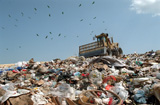Reducing Home Waste
From banana peels to cardboard boxes to cans of soda, these items are hauled to their final resting places at the landfills—to be incinerated or to decompose over months or years. In 2013, Florida’s municipal solid waste (MSW) collections grew to 31.2 million tons—an increase of 3.4 million tons from the previous year.
However, this doesn’t have to be the case. Banana peels are great for composting, and we all know that soda cans and cardboard boxes can be recycled.
While we are all familiar with the terms reduce, reuse, and recycle, learning how to implement these activities within your home can reduce your environmental footprint and conserve natural resources.
Reduce
- Buy and use long-lasting products—everything from clothes to power tools.
- Sign up for online statements or newsletters to be removed from paper mailing lists.
- Energy-efficient light bulbs and rechargeable batteries will conserve energy and save you money.
- Print double-sided on paper or on the backside of old paper.
- Purchase recycled products whenever possible—the more you buy recycled goods, the more manufactures will make them.
- Eat all the food in your home before buying more to reduce food waste.
- Make shopping fun, exciting, and eco-friendly by scouring through thrift or antique stores to buy used clothes, furniture, and other household items.
- Buy products in bulk and/or in refillable containers to minimize packaging.
Reuse
- Instead of using plastic bags every time when shopping, bring reusable cloth or canvas bags with you. (You can reuse old plastic bags, too.)
- Buy items you know you can reuse. A reusable sports bottle, for example, will save a lot of waste compared to using disposable plastic bottles.
- Share clothes, books, and other reusable items with friends and family.
- Rather than throwing away unwanted or outdated electronics and items, donate them. Remember: one man’s trash is another man’s treasure.
- When cleaning, reuse certain cleaning utensils, such as mops, rags, and sponges.
- Explore different websites, such as Pinterest and Etsy, to learn creative ways you can turn “trash” into a fun craft.
Recycle
- Find out if your community has a recycling program, and learn what you can recycle.
- Put a recycling bin near your kitchen to easily separate recyclables from garbage.
- Be sure to have the correct bins, so your recycled materials are picked up.
- Compost food scraps and yard waste—you’d be surprised how many different items can be composted. In fact, more than 95 percent of food waste that could be composted is sent to the landfills and incinerators.
Help conserve and protect our planet for future generations by taking these few small, sustainable steps whenever possible.
Adapted and excerpted from:
“Florida Municipal Solid Waste Collected and Recycled in 2013 Report,” Florida Department of Environmental Protection (Accessed 09/2014).
“Green Building: Reducing Waste,” United States EPA (Accessed 09/2014).
“Municipal Solid Waste (MSW) in the United States 2012 Infographic,” United States EPA (Accessed 09/2014).

Related Sites & Articles
- Hot Topics
- Home Energy Conservation
- Reducing Car Usage
- Reducing Thanksgiving Waste
- Sustainable Car Washing
- Water Conservation
- UF/IFAS Publications
- Enviroshopping: Buy Smarter
- Sustainable Landscape Construction
- UF/IFAS Sites
- Sustainable UF: Zero Waste
- Other Sites
- Recycling—Florida Department of Environmental Protection

